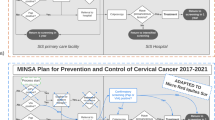Abstract
Little qualitative research has been conducted with cervical cancer survivors. We sought to understand the experiences of survivors in rural Eastern North Carolina and identify any barriers which may have kept women from receiving preventive Papanicolaou screenings or follow-up care. We conducted semi-structured in-depth interviews with 15 low-income and underserved cervical cancer survivors living in Eastern North Carolina. Participants included English-speaking women who attended a large cancer center for care between March 2012 and March 2013. Participants ranged from being recently diagnosed with cervical cancer to being 15 years post-diagnosis. Interviews lasted approximately 1 h and were audio-tape-recorded. On average, women were 55 years old (range 35–85) and were diagnosed with cervical cancer 3 years prior to the interview (range 0.2 to 180 months). A good proportion was uninsured or Medicaid-insured (60 %). Half reported an annual household income of less than $20,000, and 13 % reported having a college degree. The majority of survivors had limited understanding of cervical cancer, experienced persistent symptoms related to their cancer before seeking care, and were nonadherent to Papanicolaou screening recommendations. The main barriers to care reported by participants was lack of money and health insurance, followed by the perception of overall health (which equated to the belief that medical care was not needed), transportation issues, and discomfort with provider. Health professionals should focus educational efforts on the benefits of Papanicolaou screenings, the symptoms sometimes associated with cervical cancer, and the free or low-cost services available to low-income women.
Access this article
We’re sorry, something doesn't seem to be working properly.
Please try refreshing the page. If that doesn't work, please contact support so we can address the problem.
Similar content being viewed by others
References
World Health Organization. WHO guidance note: comprehensive cervical cancer prevention and control: A healthier future for girls and women. Switzerland, 2013. Available at http://www.who.int/immunization/hpv/learn/comprehensive_cervical_cancer_who_2013.pdf
2.Centers for Disease Control and Prevention (U.S.). Cervical cancer. Atlanta, Ga: U.S. Dept. of Health and Human Services, Centers for Disease Control and Prevention, 2009. Available at http://www.cdc.gov/cancer/cervical/
Centers for Disease Control and Prevention (U.S.) & United States. Indian Health Service. Genital human papillomavirus (HPV). Atlanta, GA: Dept. of Health and Human Services, Centers for Disease Control and Prevention, Indian Health Service, 2011. Available at http://www.cdc.gov/std/hpv/common/ai/ai.pdf
Siegel R, Ma J, Zou Z et al (2014) Cancer statistics, 2014. CA Cancer J Clin 64(1):9–29
Freeman HP, Wingrove BK (2005) Excess cervical cancer mortality: a marker for low access to health care in poor communities. Rockville, MD: National Cancer Institute, Center to Reduce Cancer Health Disparities, pp 1–96. Available at http://www.cancer.gov/aboutnci/organization/crchd/abouthealth-disparities/resources/excess-cervical-cancer-mortality.pdf. Accessed 15 Jan 2015
Denslow SA, Knop G, Klaus C et al (2012) Burden of invasive cervical cancer in North Carolina. Prev Med 54(3–4):270–276
Lea S, May C, Miller E (2012) Cancer prevention in eastern North Carolina. Cancer profile of eastern North Carolina for breast, cervical, and colorectal cancers. Greenville, NC: Department of Public Health, Brody School of Medicine, East Carolina University. Available at http://www.ecu.edu/cs-dhs/chsrd/Pubs/upload/ENC-Cancer-Profile-041612.pdf
Hildesheim A, Hadjimichael O, Schwartz PE et al (1999) Risk factors for rapid-onset cervical cancer. Am J Obstet Gynecol 180(3 Pt 1):571–577
Janerich DT, Hadjimichael O, Schwartz PE et al (1995) The screening histories of women with invasive cervical cancer. Connecticut. Am J Public Health 85(6):791–794
Peters RK, Bear MB, Thomas D (1989) Barriers to screening for cancer of the cervix. Prev Med 18(1):133–146
Sambamoorthi U, McAlpine DD (2003) Racial, ethnic, socioeconomic, and access disparities in the use of preventive services among women. Prev Med 37(5):475–484
Behbakht K, Lynch A, Teal S et al (2004) Social and cultural barriers to Papanicolaou test screening in an urban population. Obstet Gynecol 104(6):1355–1361
Eggleston KS, Coker AL, Das IP et al (2007) Understanding barriers for adherence to follow-up care for abnormal pap tests. J Women’s Health 16(3):311–330
Salz T, Gottlieb SL, Smith JS et al (2010) The association between cervical abnormalities and attitudes toward cervical cancer prevention. J Women’s Health 19(11):2011–2016
Cyrus-David MS, Michielutte R, Paskett ED et al (2002) Cervical cancer risk as a predictor of Pap smear use in rural North Carolina. J Rural Health 18(1):67–76
Ashing-Giwa KT, Kagawa-Singer M, Padilla GV et al (2004) The impact of cervical cancer and dysplasia: a qualitative, multiethnic study. Psycho-Oncology 13(10):709–728
Guilfoyle S, Franco R, Gorin SS (2007) Exploring older women’s approaches to cervical cancer screening. Health Care Women Int 28(10):930–950
Waller J, Jackowska M, Marlow L et al (2012) Exploring age differences in reasons for nonattendance for cervical screening: a qualitative study. BJOG-Int J Obstet Gy 119(1):26–32
NVivo qualitative data analysis software; QSR International Pty Ltd. Version 10, 2012. Available at https://www.qsrinternational.com/support_faqs_detail.aspx?view=11. Accessed 15 Jan 2015
The UNC Lineberger Comprehensive Cancer Center and NC Central Cancer Registry Cancer in North Carolina. 2008 Report: cCancer and income with a special report on cancer, income, and racial differences. North Carolina: North Carolina Center for Health Statistics, 2008. Available at http://ucrf.unc.edu/publications/cancer_report_2008.pdf
Acknowledgments
We would like to thank the women who participated in this study for openly sharing their experiences with us and Samantha Billings, Ashley Allsbrook, Camden Heath, and Katlyn Eloshway for assistance with interviewing and transcription. We would also like to thank the staff from the cancer center for graciously allowing us to recruit study participants from their center and for their continued fight against cervical cancer.
Conflict of Interest
This study was unfunded and authors have no conflicts of interest to disclose.
Author information
Authors and Affiliations
Corresponding author
Rights and permissions
About this article
Cite this article
Richman, A.R., Troutman, J.L. & Torres, E. Experiences of Cervical Cancer Survivors in Rural Eastern North Carolina: a Qualitative Assessment. J Canc Educ 31, 314–321 (2016). https://doi.org/10.1007/s13187-015-0809-0
Published:
Issue Date:
DOI: https://doi.org/10.1007/s13187-015-0809-0




